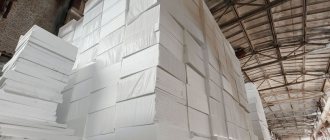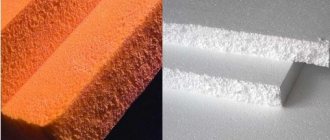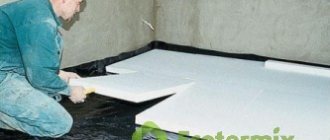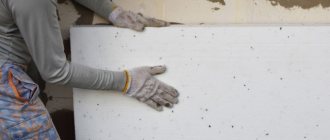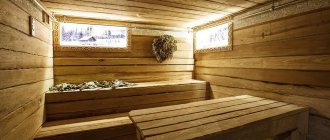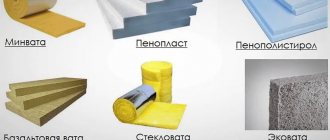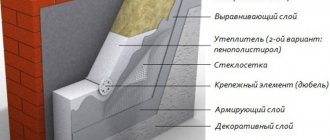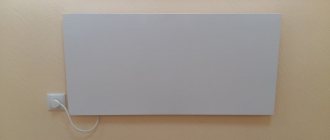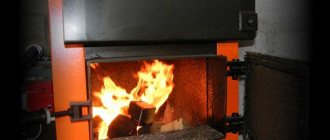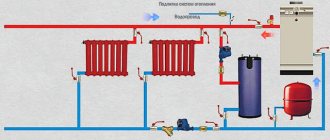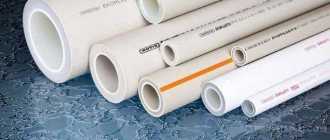Polystyrene foam is a very convenient and easy-to-work material. It has high thermal insulation characteristics, does not rot, and is resistant to moisture. Due to its performance qualities and affordable cost, polystyrene foam has become very popular. It can be glued to almost any surface: drywall, concrete, wood, brick. In addition, you can glue foam to metal. This is somewhat more difficult to do than with other surfaces, but this work can still be done with your own hands. First of all, you need to figure out how to glue foam to metal and how to do it.
Modern adhesive compositions allow you to glue foam sheets to any surface: concrete walls, brickwork, metal sheets. For gluing at home you can use: liquid nails, polyurethane foam, silicone sealants.
Types of glue for installing polystyrene foam boards
Adhesive compositions for installing insulation boards of this type are of two types: specialized and universal. The first type is intended for installation of only a specific insulation. Universal adhesives are more preferable because... they not only qualitatively fix the insulation to the wall surface, but also create a reinforcing layer. Glue can be made on the basis of bitumen or a cement-polymer substance.
Mastic-based solutions are capable of creating a waterproofing layer due to the high bitumen content in their composition. However, the application of such adhesive must be carried out continuously, without visible breaks. Among other things, such adhesive does not require thermal exposure before installation, and the adhesive mass is always highly plastic.
Adhesives based on cement-polymer materials are used for all types of work. They do an excellent job of installing polystyrene foam on concrete, brick foam concrete surfaces, as well as on drywall. Before carrying out work, it is necessary to thoroughly prime the surface.
Insulate from the outside or from the inside?
In modern construction, there is a rule: insulate a house from the inside only if it is impossible to do it from the outside. And not by chance. With external insulation, the walls are protected from external influences - atmospheric and temperature, from hypothermia (and freezing), condensation, and extraneous noise. Accordingly, with facade insulation, the building is more durable. This means that in this case the adhesive for insulation should be chosen, intended only for external use.
From all of the above, the logical conclusion follows that the preferred type of home insulation today is facade insulation, using mineral wool insulation. All that remains is to figure out the installation: choose the adhesive for mineral wool and use it correctly.
Attach penofol with the foil side facing the inside of the room. A greater thermal insulation effect is created by an additional air layer 1-2 cm thick (using a backing - sheathing).
By watching the video you will learn more:
Glue of different compositions for polyethylene foam can be ready-made or requires preparation on site. You must carefully read the instructions for the selected mixture:
- The glue is applied in an even layer, paying special attention to the edges. Before sticking, you need to wait up to 1 minute so that the composition has time to be slightly absorbed. This ensures better adhesive properties. Attach the treated penofol to the insulated surface. The plates are fastened joint to joint, but not overlapping;
- setting time varies depending on the characteristics of the glue (at least 15 seconds);
- smooth the surface of the polyethylene foam, removing folds. Tape the seams, you can use foil tape;
- glued insulation in residential premises requires additional decorative finishing. The last layer of the structure (plasterboard or lining) is installed on the sheathing.
Nothing brings satisfaction more than a job done correctly and skillfully. If you follow all the recommendations, attaching the insulation will not cause much trouble.
Tips and instructions for gluing foam
First of all, you need to remember a number of general rules for gluing foam plastic, which must be taken into account regardless of the chosen adhesive composition:
- Glue must be applied in at least 5 places.
- No manipulations should be performed with the panels until the glue is completely dry.
- In the case of external pasting, it is necessary to select a composition that would correspond to the temperature and weather conditions of the region where you live.
Before gluing the sheets, you need to prepare the surface. First of all, it is cleaned of old paint, dirt, rust, etc., and then degreased.
Silicone, liquid nails and similar mixtures are applied pointwise or in stripes in increments of 5-7 cm.
It is this distance that allows for the most reliable gluing of the foam to the metal surface. If dry mixtures are used, the sheet will need to be additionally pressed over the entire area with plywood.
For work you will need the following materials:
- Degreaser. The metal surface can be treated with technical alcohol, gasoline, white spirit, kerosene and compositions specially developed for this.
- Means for gluing sheets. To choose from: foam, silicone sealant, aerosol glue, PVA, liquid nails.
- If possible, burlap.
- If foam or spray adhesive is used, you need to prepare a special cleaning solvent.
During work you will need the following tools:
Tools required for gluing foam: degreaser, sheet adhesive, knife for cutting foam boards, spatulas, gun, measuring tape.
- Wooden board or sheet plywood in case of using dry adhesive mixtures.
- Unnecessary clean rags.
- Protective gloves.
- Knife for cutting foam boards.
- Spatulas.
- Gun when using polyurethane aerosol adhesive.
- Yardstick.
Gluing is very simple, everything is done in the following sequence:
- The metal surface is cleaned and degreased.
- The selected adhesive composition is applied to the foam sheet.
- The sheet leans against the surface with slight pressure. When using a dry mixture, it is additionally pressed with plywood or a wooden board until the glue dries.
Thus, working with foam is simple, easy and profitable. The set of tools and materials is minimal. Before purchasing a composition, be sure to make sure that it is suitable for use in your climate zone and does not contain gasoline, acetone or other solvents. Good luck!
Types and characteristics of foil material
Today there is a wide range of these products manufactured by numerous manufacturers. It may differ in markings, have different names, have different technical characteristics, but, in essence, it will be a foil insulator.
In order not to get lost in such diversity, you should clarify the main points that impose certain properties on a particular material, depending on its composition.
Thus, the insulator base treated with foil on one or both sides improves the reflection of infrared radiation, moreover, this indicator also depends on the method of application and its material (silver, golden).
As for the base itself, mention should be made of its most common types.
♂️ No less important information on the topic: Insulation for bath walls
Universal foil insulator based on polyethylene foam
The most common type of base is polyethylene foam. On the construction market it is presented both without foil and with one-sided and two-sided application.
It has gained wide application due to its versatility, since it is used everywhere - it can be found both in the insulation of floors, ceilings and walls of houses, cottages, garages and other outbuildings. It is also often used in automobile, carriage, ship and “the like” construction; it is actively used in the field of packaging, where temperature conditions are important.
In other words, versatility lies in its heat, noise, hydro, steam, and vibration functionality. It is made by saturating molten polyethylene with air; the greater the saturation, the higher the insulation performance. The volumetric weight can vary several times: from 20 to 300 kg/m³, and the density can vary between 300-700 kg/m³.
Foil-coated PPE is produced mainly in rolls, plates, bundles, as well as in cylindrical forms for insulating heating mains. The thickness of the base can be from 4 mm to 50 mm, and the foil thickness is no more than 15 microns (usually).
Comparison table
Foiled mineral wool
This type has better insulating properties, but at the expense of its strength. Therefore, its use is narrower - external insulation of load-bearing structures, heating mains, attic rooms, as well as frame buildings.
Despite its excellent performance, it should not be glued in rooms with high moisture. Foil wool absorbs water well and loses its structure. In house construction, it will show its advantages to the maximum when insulating attics and roofs of houses.
If we talk about mechanical loads, then mineral wool has no resistance to them at all - a slight use of force will lead to instant destruction of the structure, so using it as floor insulation is out of the question.
Foil wool is actively used to insulate surfaces with high temperatures: pipelines, heating elements, etc. Mineral wool belongs to the class of non-flammable (NG) and is not afraid of open fire, so you can be sure that the insulated wooden surface will not heat up to the level of spontaneous ignition.
Foil mineral wool
Foiled polystyrene foam insulation
The next popular material is polystyrene foam. It is made from ordinary polystyrene foam and is its derivative. Dense, finely porous, elastic and durable, good mechanical properties. If you do not exceed the maximum weight load, it does not have a memory effect, and is able not to sag under the weight of an adult man.
This insulator is used as a base for installing heated floors. Manufacturers who produce it specifically for these purposes apply marking lines on the foil side, specifically to make it easier for builders to correctly form (lay) the heating elements.
Installation of heated floors
It is practically not used as a heat insulator for walls, this is due to economic inexpediency - the properties are the same as those of cheaper analogues, but the price is higher.
Adhesive for fixing polystyrene foam
Speaking about how to glue polystyrene foam to wood, you should know that this can be done using various ready-made adhesives.
Polystyrene foam has low adhesion to many materials: wood, concrete slabs, brick. However, polystyrene foam can be easily glued to these materials using any of the following compositions: cement and dry adhesive solutions, frost-resistant adhesives, sealants for external surfaces, etc. You will need to make a reliable adhesive connection that will prevent the formation of mold and mildew. In addition, the connection should not impair the beneficial properties of wood and polystyrene foam boards.
Cement-based dry foam adhesive is a durable and inexpensive option.
One of the most durable and budget-friendly mixtures is dry foam glue, which is made on the basis of cement. Before use, it must be diluted with water. This mixture has high adhesion to almost any material. There is a fairly large assortment of polymer cement-based solutions on sale, which are intended for gluing polystyrene foam boards on all types of substrates. To secure external thermal insulation, you can use an effective polymer-cement composition with mineral fillers. Compositions from some manufacturers can be used to provide protection to polystyrene foam on the front side. The only drawback of such mixtures is that they will harden for approximately 3 days.
You can also use special aerosol mixtures based on polyurethane. They can be suitable both for gluing insulation and for filling seams and voids between slabs. Similar polyurethane-based solutions can be used to secure expanded polystyrene to the internal and external bases of walls, roofs, floor bases, and facade elements. The relatively high cost of such adhesive mixtures is offset by the ease of use and reduction of setting time. You should know that foam plastic boards can be fixed within 2 hours after applying the glue. Additionally, the slabs must be secured with façade anchor bolts.
Polyurethane-based adhesives are fire-resistant, retain their performance characteristics over a wide temperature range and do not emit harmful fumes. All this was achieved thanks to special technical techniques for producing compounds.
In some cases, it may be necessary to glue foam boards together. To do this, you can use any wet or dry adhesive mixture that does not contain solvents.
Each of the adhesive mixtures has its own advantages and disadvantages. You need to choose based on your needs.
How to choose glue
There is a fairly wide range of different adhesives for sale for working with polyethylene foam. And it is advisable to make the choice using the following criteria.
- The temperature range must match this characteristic of the insulation.
- Adhesive properties must be extremely high.
- If you plan to use glue for interior decoration, it must be certified and non-toxic.
- If adhesive is selected for exterior finishing, it must be resistant to a variety of weather conditions and temperature changes.
- If you intend to finish the sauna and bathhouse, then the glue will need to be mixed with water-repellent agents.
Water-based adhesive is absolutely not suitable for working with isolon, because it does not allow the adhesive to penetrate into all the pores of the insulation. Consequently, the level of adhesion will be insufficient.
Is it advisable to use foam?
With the help of foam, you can simplify and speed up working with foam several times over. It is perfect for those cases when you need to do everything quickly and efficiently. It features high technical characteristics and low consumption. Sold in cylinders, making it easy to transport and use. Compared to simple dry mixtures, it is more expensive, but it pays off, because... 1 cylinder is enough for an average of 20-25 square meters.
The main advantage over aerosol adhesives is that you do not need to use water, electricity or any special equipment to work with foam. During the insulation process, it is possible to save up to 50% of time compared to other popular compounds.
https://youtube.com/watch?v=uKnBQD0SwYo
There is no need to take technical breaks, there is no need to install a layer of reinforcement or drive in dowels, you can work even in cold weather. The foam is characterized by excellent adhesion to polystyrene foam. Resistant to fire and high humidity. Does not support combustion and does not emit substances harmful to human health.
How to glue correctly: advice from professionals
Preparatory work
High-quality penofol adhesive is not a guarantee of a positive outcome. In order for the material to firmly adhere to the base and to restore a reliable monolithic screed between the elements, it is necessary to properly prepare the intended plane for the front of the work. To do this you need:
Gluing stage
Modern industry has simplified the fastening process by developing self-adhesive penofol. Ordinary polyethylene foam is glued using a special adhesive. The selected glue is applied in an even layer to the side where there is no foil. The edge parts of the penofol are lubricated with the substance more abundantly to avoid material lag at the joints. To ensure that the glue sets properly, wait 1 minute, then glue the polyethylene to the plane. To ensure high-quality installation of the material, the penofol is leveled and pressed until it is fixed. The resulting seams are additionally treated with glue. The plastered structure can be used 12 hours after installation of the heat-insulating material.
What is most often used for gluing foam?
When figuring out how to glue polystyrene foam to a metal surface, you need to start from a number of basic points, taking into account which you can choose the most suitable composition. First of all, it is necessary to consider the type of surface to which the material will be glued.
You should definitely pay attention to the type of foam itself. Otherwise, the choice of composition with which it would be possible to glue foam plastic to a metal surface comes down to determining the most economically advantageous option
Before choosing a suitable adhesive composition, you should take into account the type of foam and pay attention to the surface to which the material will be attached. Polystyrene foam can be glued to metal using various dry mixtures, aerosol adhesives, silicone sealants, polyurethane foam and any other materials that do not react with foam plastic.
It is important that the glue does not contain gasoline, acetone or other solvents. They will simply “burn through” the material
When choosing a composition, pay attention to its components and price
Polystyrene foam can be glued to metal using various dry mixtures, aerosol adhesives, silicone sealants, polyurethane foam and any other materials that do not react with foam plastic.
It is important that the glue does not contain gasoline, acetone or other solvents. They will simply “burn through” the material
When choosing a composition, pay attention to its components and price
Currently, one of the most widely used materials for gluing foam is polyurethane foam. It is able to adhere to any materials and has many positive properties, namely:
- You can work with her even without such experience.
- Foam allows you to efficiently, easily and quickly glue foam to any surface, including a metal surface.
- The composition is quite cheap and is sold in cylinders, which makes its use as convenient as possible. In addition, with the help of foam you can not only glue foam plastic, but also seal the seams between individual slabs.
The only drawback of this material is that it dries out very quickly, as a result of which the tube may simply become clogged before the entire composition is used. This problem is solved by washing the tube with a special solvent. If you use foam, it is better to immediately buy this solvent.
Polyurethane foam will not only allow you to quickly and cheaply glue foam to a metal surface, but will also help seal the seams between the plates.
One-component polyurethane adhesive is also often used. It is also sold in cylinders, but requires additional costs for the purchase of a special pistol.
Some home DIYers glue foam using a combination of glue and liquid nails. The latter set quite quickly, making work much faster and more convenient than with simple glue. However, liquid nails are less reliable than glue, so using them alone is not recommended, especially if the foam is glued to an inclined metal surface or to the ceiling, for example, in a garage. In most cases, approximately 65-70% of the panel surface is treated with glue, and the remaining part with liquid nails. This allows you to work without using plywood supports, as required when working with glue alone.
If you need to cover a small metal surface with polystyrene foam, you can get by with simple double-sided tape. However, in monetary terms it is much more expensive than other adhesives, so it is advisable to use it only for very modest repairs.
If you can attach burlap to the metal surface before gluing the foam, it will make the rest of the job even easier. It will be possible to use ordinary construction PVA. This composition is relatively inexpensive and easy to use.
Using polyurethane glue
When thinking about how to glue foam plastic to metal, the consumer quite often chooses polyurethane glue; it is the most suitable for carrying out this work. The mixture is available in convenient cylinders, but you will also need a mounting gun. If the work is single, then it is best to purchase a cheap tool, because it will not be used constantly.
If you decide to resort to this technology, then you must follow a certain sequence of actions. The adhesive is applied to the surface of the thermal insulation in dots or strips; the distance between individual dots should be approximately 7 cm or less. After waiting a few minutes for the dots to dry a little, the plate must be carefully pressed against the metal surface. This is exactly the case when the slabs need to be supported with plywood or boards. After just 20 minutes, the support can be removed.
Feasibility of using foam
The use of foam as an adhesive makes working with foam faster and easier. Its use is advisable if all actions need to be carried out efficiently and quickly. The product is characterized by low consumption and excellent technical characteristics.
Advantages of using foam:
- ease of operation;
- there is no need for technical breaks - the work time is halved;
- no need to hammer in dowels or install a layer of reinforcement;
- installation work can be carried out even in the cold season;
- has increased resistance to fire.
Foam is more expensive than simple dry mixes, but is worth the expense. 1 cylinder is enough for 20-25 m2. Even a beginner can carry out installation work on gluing foam plastic to metal, subject to certain rules. By making the connection yourself, a novice master will be able to save money and also be confident in the quality of the work performed.
How to prepare the surface
No matter what adhesive is used, the preparation process is always the same. If the metal is not properly processed, then no glue will provide reliable fastening of the foam.
Materials and tools for work:
- Metal brush . Used to clean the surface and remove rust and old paint residues. Instead of a hand tool, you can use a power tool - a drill or grinder with a special metal brush;
A special wire brush will help you quickly remove rust and paint from the metal surface.
- Paint remover . It is used if there are several layers of old paint on the surface, which does not adhere very well and may peel off later. The composition is easy to apply, but is toxic and requires compliance with safety measures;
Paint remover in aerosol packaging is very convenient to use
- Solvent. Used to degrease surfaces. Personally, I use the P-646 composition; it is inexpensive and well suited for preparing metal for further processing;
Solvent R-646 is used for cleaning and degreasing metal in preparation for insulation
- Composition “3 in 1” for metal surfaces . A special composition consisting of paint, primer and anti-corrosion treatment. After application, the surface will be reliably protected from rust for many years. If you have metal without pockets of corrosion, then you can use ordinary primer for metal, its price is much lower;
Special paints with anti-corrosion additives are the best preparation of metal for insulation
- Brush or roller . Used for applying paint. For large, flat areas, a roller is more suitable. For designs with many curves and angles, it is better to use a brush.
The brush should have thick bristles to ensure high-quality application of paint or primer to metal
Metal surface preparation:
The paint can be applied with a sprayer if available, but you can also use a brush.
The nuances of proper gluing and reinforcement of polystyrene
If you plan to glue products made of extruded polystyrene foam and conventional foam, the following nuances of the technology should be taken into account:
- polystyrene is processed using a needle roller for better adhesion;
- It is recommended to cover the foam with long-fiber paper.
If you need to solve the problem of how to increase the strength of a structure based on foamed polymers after gluing, you should use the following recommendations:
- in the case of interior decor or crafts made from foam plastic, the solution is to create an external reinforcing frame made of paper;
- if it is necessary to reinforce structural elements, it is advisable to use fiberglass.
Also, polystyrene foam can be “armored” using gypsum or acrylic plaster.
Properties of foam plastic
Foamed polystyrene is a lightweight white polymer consisting of tightly compressed balls containing air. Polystyrene foam is very popular due to the following advantages:
- affordable price;
- ease of processing;
- non-toxic;
- inability to burn independently;
- waterproof;
- high thermal insulation potential;
- frost resistance;
- good sound insulation;
- resistance to fungus and other microbiological factors.
Styrofoam
Installation technology
Before starting work, you need to check that you have all the necessary tools that may be needed throughout the entire foam installation process.
Below is a minimal list of what may be useful when working:
- Gloves and cloth material; It is better to have rubber or cloth gloves; the use of cellophane gloves is unacceptable.
- An industrial knife that will be used to separate sheets of foam.
- Tape measure for precise area measurements.
- Several spatulas.
- A piece of wood or plywood to support the foam boards.
- A grinding machine that thoroughly cleans metal.
- Surface degreasing agents: white spirit, gasoline or any other detergent.
- An adhesive solution that was selected in accordance with operating conditions.
- The required number of foam sheets.
First, you need to especially thoroughly clean the metal surface from any dirt, rust or paint residues on it, and then completely degrease the entire area of the metal surface with any available means. The modern construction industry offers a huge number of adhesive materials, the use of which mainly depends on the personal desire of the installer. They all have both positive and negative sides.
Using polyurethane foam
Polyurethane foam is quite convenient and easy to use and does not require any special skills to use it. It adheres to absolutely any surface, but it dries quickly enough, so delay is unacceptable when working with it.
The foam is produced in small cylinders that have a convenient outlet tube. This helps to apply it quickly and ensures high quality installation. Polyurethane foam is the simplest material for working with foam and metal.
Application of polyurethane glue
This type of glue has become the second most popular for home use in small quantities. The form of release of polyurethane glue is identical to the form of release of polyurethane foam - small cylinders with a guide outlet tube, however, to work with polyurethane glue you need a special gun that squeezes the mixture onto the desired surface.
Polyurethane adhesive is usually applied in dots or stripes over the entire surface of the foam sheet.
Liquid nails for gluing foam to metal
Liquid nails have lower surface bonding strength than the previous option, but after the first contact of the surfaces there is no need to provide support for the foam sheet.
Using PVA glue
If you want to use PVA glue for installation, then this method will provide a fairly good degree of adhesion of the foam, but you will need to create an additional layer between the surfaces with burlap. To make the work easier, you can first glue the burlap onto the foam, wait until it dries, and then continue working.
For finishing small areas with polystyrene foam, it is possible to use double-sided construction tape. This type of connection is of very high quality, as well as a high price. If you are not afraid of excessive financial costs, then this method is for you.
So, as you can see, there are no particular difficulties when installing various types of insulation. Of course, if you are doing this for the first time, then you will need some time to develop the necessary skills, but, as practice shows, almost every person is able to do this work on their own. In this case, you will not only be confident in the high quality of the installation, but you will also be able to save a fairly large amount of financial resources that can be spent on more important things in your home.
Which side to place the insulation with foil (penofol)
February 15, 2014. Read 112328 times
Insulation with foil is a highly effective heat-insulating material, the basis of which is foamed polyethylene, with a top coating in the form of aluminum foil, with good heat-reflecting ability.
For internal thermal insulation
The following types of insulation with foil can be used indoors:
A (foil on one side)
B (foil on both sides)
C (on one side there is a foil layer, on the other there is a self-adhesive layer)
For outdoor use
The following types of embossed insulation are used:
M (flat side coated with aluminum foil)
R (coated with aluminum foil on the embossed side)
When starting work, you should know which side to place the rolled insulation with foil when installing it. Insulation with foil should be laid with an aluminum screen inside the room, and the other side should be glued to the surface to be insulated. Foil is a good conductor of heat, so it should not heat up. For this purpose, material manufacturers recommend leaving an air gap of 2 cm between the finishing material and the screen. The gap plays the role of a heat insulator, so the remaining free space must be well sealed.
Which side should you put the insulation with foil on the balcony?
To insulate the balcony, you should use embossed insulation with foil. The material is laid so that the reflective surface is directed inside the balcony, as shown in the photo.
Which side should the insulation with foil be placed on the floor?
To create a warm floor, one-sided foil insulation 3-4mm is suitable. The insulation is laid with an aluminum coating up, along the joists, evenly over the entire surface.
We also recommend:
Comments:
Add a comment Cancel reply
Can I lay a foil layer against the walls on the balcony if I adhere to the goal of preventing excessive heating in the summer and not letting heat out of the apartment in the winter?
Relevant. Similar question. I insulated the balcony in the following sequence: laid 10 mm penofol with the foil side facing the wall, 50 mm mineral wool, vapor barrier, plasterboard. The idea was to isolate the mineral wool from moisture on both sides. Is this arrangement of penofol possible?
Good afternoon Can you tell me which side to insulate the attic from the street side? foam inside and foil outside?
Is it possible to use it to cover a wall made of sleepers and drywall on top, to avoid the smell and stains from creasote?
Is it possible to use it to cover a wall of sleepers, then drywall, to avoid stains and smell from creasote?
Greetings! In a wooden house, I plan to install Penofol (A) on the front door, on the inside of the apartment. Is it the right idea, and the method of strengthening is scotch nails?
GOOD DAY! No one has tried to insulate grapes for the winter. If not, then you can try. Thanks in advance.
What do you have in mind?
They say that insulation with foil is hazardous to health and can contribute to the development of cancer. Is it true?
Tell. Which side should you wrap the gas chimney pipe with foil insulation correctly to avoid condensation?
Specify the name of the insulation. In the general case, vapor barrier (foil) is installed on the “heat” side and in general there is no great need for foil insulation of ventilation ducts/chimneys - because there are usually no conditions for the movement of steam into/out of the chimney insulation pie.
Is it possible to sheathe the outside of a house made of timber 150150 with penofol, if so, how to do it correctly
You can, but why? Penofol is used mainly for interior decoration. You can attach it with a stapler.
We covered the inside of the house with double-sided insulation, used spray adhesive, and then trimmed it with decorative boards; behind the radiators we left it unfinished! It turned out good! I liked the effect, so they did the same in the car, the car became generally luxurious, in the summer the air conditioner works easier, and in the winter the stove warms up the interior faster, and the heat lasts much longer!
How to glue foam to other materials?
Some types of glue designed to hold sheets of insulation together are not suitable for other materials. Therefore, when choosing a composition, it is necessary to take into account the characteristics of the surfaces to which the insulation sheets will be attached.
- Concrete. When insulating the walls of a house under siding, foam plastic is attached directly to the concrete. The most universal adhesive option for such insulation is polyurethane foam or PVA.
- Metal. Liquid nails, polyurethane glue, and PVA are suitable for attaching polystyrene foam to metal. Also, a good result will be when using double-sided tape if the area to be pasted is small.
PVA glue
- Textile. For gluing fabric surfaces, aerosol or universal glue and liquid nails are usually used.
- Glass. The best option for bonding polystyrene foam to glass would be epoxy, universal or spray adhesive.
Adhesive spray
Paper. To increase the thermal insulation of a room, the walls of the house are often insulated from the inside, after which cosmetic repairs are carried out
It is important to remember that you cannot glue wallpaper over polystyrene foam. It is necessary to cover the insulation with plasterboard
And for wallpaper, regular wallpaper adhesive is suitable. Tree. To glue insulation to wooden surfaces or plywood, instant or polyurethane glue and liquid nails are used.
Useful tips
Several recommendations for choosing material and gluing technology:
- before purchasing, check the composition of the glue and make sure there are no components that destroy polystyrene;
- buy glue with a small reserve in case of possible overuse;
- pre-test the adhesive composition on an unnecessary piece of foam;
- for better adhesion, sand the surface of the polystyrene foam with sandpaper, walk over it with a needle roller or make notches;
- on large parts, glue should be applied around the perimeter and pointwise, in several places - along the inner surface;
- When gluing with polyurethane foam, leave the fragments under pressure until completely dry.
I hope the material presented is enough to glue foam in any situation. The next video is about how to use hot melt adhesive to join polystyrene foam.
Features of working with dry mixtures
Scheme for applying glue to polystyrene foam.
The most budget option is gluing using a dry mixture, which is diluted with a certain amount of water immediately before use. Such mixtures are made on a cement base. Before gluing foam using this mixture, be sure to read the information on its packaging. It must be indicated that it is intended specifically for working with foam plastic. Such mixtures are reliable and durable. Before gluing foam plastic with them, it is necessary to thoroughly clean the surface of various dirt, remove, if any, remnants of old plaster and any kind of delamination. Manufacturers of such mixtures recommend priming the working surface before gluing the foam.
The mixture can be applied to individual areas or as a continuous layer
It is important that there are at least 5 glue application points on each sheet of foam.
Preparatory stage - what is important to do before gluing?
Polystyrene foam can be glued to almost any material. Gluing concrete, wood, plastic and polystyrene will take place without any special incidents - almost any glue or putty mixture will do. But with metal things are somewhat more complicated. It is attempts to glue these materials that lead builders to numerous mistakes.
The most common mistake is choosing an adhesive that contains acetone, gasoline or another solvent. Gluing foam boards using such adhesive bases leads to the destruction of the boards themselves. The second type of error is an insufficient amount of adhesive. It must be applied to the back side of the foam boards in at least five places - in the corners and in the middle. In order to save money, many builders apply glue at only three points, which is fundamentally wrong and violates the entire technology.
Required Tools
The set of tools and auxiliary materials required for gluing foam depends on the fixing agent used. In any case, you should prepare:
- polystyrene foam of the selected thickness, its quantity should be equal to the area that needs to be covered plus 10% for waste;
- a small spatula and a rag to remove excess adhesive mass; if they are not removed, hard lumps will form;
- a primer for treating the main surface to which the foam will be attached;
- wide primer brush;
- knife for cutting foam.
If you plan to additionally secure the slabs with dowels, then you need:
- hammer drill with 10 mm drill;
- hammer;
- special dowels shaped like umbrellas (fungi).
Installation of polystyrene foam on the balcony
When using a dry mixture, the following are additionally required:
- tap water;
- plastic mixing container;
- construction mixer (drill attachment);
- spatula-comb for applying the composition to the foam.
If aerosol glue is used, then a special mounting gun is required into which the can is inserted.
How to glue two pieces of polystyrene?
Today, for gluing polystyrene blocks together, most people prefer special adhesive foam. This is easily explained, because the foam is immediately ready for use. No additional components are required, and you do not have to prepare a solution. Foam is sold in cans, but to use them you need a mounting gun. With this single tool, even an amateur can apply foam to the surface in an even layer. Also, the advantages of glue include:
- ideal adhesion - superior to all dry mixtures;
- efficiency - minimal consumption of substance, one cylinder allows you to treat an area of up to 15 square meters;
- versatility - used both for gluing blocks and for caulking joints.
- It can be added that it adheres perfectly even at very low temperatures.
Choosing glue for polystyrene
If you have a question about how to glue polystyrene, you need to pay attention to the primary characteristics of the glue that is offered to you. This:
- safety - avoid containing hazardous chemicals in the glue;
- moisture resistance - condensation and exposure to water should not affect the stickiness;
- grip on surfaces should not be below average;
- resistance to climate change;
- density - the glue must be thick enough so as not to drain from the surface;
Expanded polystyrene - what's what and why?
The correct technical name for the well-known polystyrene foam is expanded polystyrene. If you look closely at this material from a short distance, you will find that it consists of many small balls that stick together - these are polystyrene granules that have been foamed under high pressure and temperature and compressed in a press.
Because of this technology, in the structure of the foam there are many invisible microcells in which air is located. Thanks to this, the material acquires airy lightness and the properties of a very good insulation. Consumers fell in love with it for its extremely low cost - in fact, it is the cheapest thermal insulator, and builders appreciated its technical characteristics. We will dwell on this in more detail, because along with the popularity of the material, like mushrooms after rain, numerous myths about its shortcomings also grew.
Polystyrene foam is very durable - polystyrene retains its shape for at least 25 years when used outside and for at least half a century when used inside. You will probably be surprised, because many people talk about its fragility. Indeed, ultraviolet radiation and constant exposure to moisture can shorten the service life. But these same factors can shorten the life of almost any building material, including various types of insulation.
Expanded polystyrene is not afraid of mold and fungi - thanks to this, it can also be used in a humid environment, for example, in a basement. Polystyrene granules practically do not absorb moisture. However, they say that all kinds of rodents can easily make holes in polystyrene foam. Again, this is only partially true - if rodents have something to eat, they will make holes even in concrete. Deprive them of food or kill them with poison, and you won't have to think about their relationship with the foam.
Foam plastic does not support combustion - no matter what they say, but this material is many times safer than the same wood. In order for it to ignite, the temperature is twice as high as in the case of wood, and when burning it produces much less heat. The material is safe for human health and the environment - among the common myths there is also the myth that the material is allegedly harmful to human health. But dozens of studies have already refuted this myth a long time ago. Look around you, there is a huge amount of much more harmful materials around you.
One of the disadvantages of polystyrene foam is its low strength - it breaks easily, and even a small blow can leave a dent on its surface. For this reason, it must be protected from mechanical damage - traditionally, plaster mixtures are used for this. They also protect the material from exposure to ultraviolet radiation.
Features of the material
The basis of the material is polystyrene. It foams in production. This technology is often used, for example, in the manufacture of isolon and other insulators. Granular plastic is treated with water steam. As a result, the granules increase in volume, filling with air, and stick together. The result is a light, fairly strong mass consisting of 95% air. Therefore, expanded polystyrene, as it is also called, has good insulating characteristics. It traps heat and sound waves.
Its surface is quite dense, suitable adhesive paste fits well on it. But some products don't stay on smoothly. They cannot be used. When cutting, poorly held granules may fall out. Then a torn cut is formed, which is very difficult to glue smoothly. This must be taken into account when cutting. It is better to use a thermal cutter or a very sharp knife.
Review of popular brands
The adhesive composition used for gluing polystyrene foam sheets to metal must be characterized by:
- endurance to decrease in temperature;
- possibility of use for outdoor work;
- absence of any solvents in the product;
- guaranteed high degree of adhesion of bonded surfaces;
- ease of use.
It is preferable to choose a composition that contains composite mixtures, bitumen or plasticizers.
"Ceresit"
Due to their high quality, the brand’s products are respected by professional builders. Advantages of the adhesive composition "Ceresit":
- Ideally applied to foam blocks;
- good ductility;
- can be used for interior and exterior work, resistant to temperature changes and various atmospheric phenomena;
- impact-resistant, vapor-permeable composition;
- environmentally friendly;
- long period of adjustment (20-25 min.).
Disadvantage: The working solution must be used within 2 hours.
"Moment"
The Moment glue line is expanding every year. Positive properties of the composition:
- even with prolonged use, the adhesive seam does not crack;
- has excellent technical characteristics;
- does not shrink or deform when dried;
- frost resistance, water resistance, heat resistance;
- the adhesive is available in containers of different volumes;
- short drying period.
The disadvantages include the unpleasant odor of the glue (disappears only after complete drying), and is more often subject to counterfeiting (as a result of which the composition contains toxic components that are harmful to health).
"Master Termol"
Combined adhesive for polystyrene foam “Master Termol” has the following properties:
- long period of adjustment of slabs (up to 50 minutes);
- high adhesion and ductility;
- the composition is environmentally friendly;
- the lowest temperature for using the mixture is -5 ˚С, which allows installation work to begin earlier and finish later;
- the technological movement time is 12 hours, after which the foam can be doweled.
Time to use the finished composition is 30 minutes, material consumption per 1 m2 is 6 kg.
"Profline 3K-45"
An adhesive mixture for installing foam plastic and mineral wool, which is suitable for interior and exterior decoration. Positive properties of the composition:
- ease of use;
- moisture resistance, elasticity, frost resistance;
- economy;
- high adhesion;
- Shelf life of the finished mixture is 2 hours;
- environmentally friendly product.
During preparation of the composition, preventive safety measures should be observed. The dry mixture is characterized by increased dust formation, so it is necessary to protect the eyes and respiratory tract from it.
"Penoplex Fastfix"
Highly effective composition for installation of thermal insulation. Advantages of glue:
- universal - glues foam equally well to various surfaces, including metal;
- ease of use - time for preparing the adhesive is reduced;
- heat resistance – not afraid of temperature differences from -50 to +90 ˚С;
- after the glue hardens, thermal conductivity is not impaired;
- no shrinkage.
Those who have used Penoplex Fastfix adhesive consider the disadvantages to be the fact that the amount of work performed to cover the surface does not correspond to what is mentioned on the packaging; it is much less.
What varieties are suitable
In order to reliably connect puzzles into a single picture, various gluing means are used. Both special glue and those intended for other household purposes are used.
Specialized
Along with a set of puzzles, special glue is often placed in the box. It has a liquid consistency and is able to penetrate between elements and firmly connect them. The glue is odorless and colorless; it can form a glossy layer on the front side, after which the picture does not need to be varnished.
PVA
The properties of special glue and PVA are not very different. To reliably connect the assembled puzzles, PVA is applied to them along the front side with a brush, filling all the joints and gaps. After drying, white stains will become transparent and form a matte film on the surface of the glued picture.
Wallpaper for vinyl coverings
Elastic adhesion of the elements can be obtained after using glue for vinyl wallpaper. The advantage of the composition is the ability to prepare glue of different thicknesses.
Rating and review of the best brands
You can purchase several brands of puzzle glue in specialized stores. They differ in the quality of the adhesion and the appearance of the glued elements.
Step puzzle
Step puzzle glue is odorless, dries in 2 hours, 80 ml is enough to glue 1000 puzzle pieces. It is poured onto the front surface of the painting in two layers with a break of 1.5 hours. A thin transparent film is formed. If the parts were a little torn, thanks to Step puzzle they are neatly connected and become even. You should strengthen the picture on the back side by applying another layer of glue to it.
Ravensburger Puzzle Conserve
The glue is convenient to use because it comes in a can designed for 4000 elements. The liquid comes from it through a foam nozzle, which does not dry out and remains in working condition for a long time. Ravensburger dries in an hour, leaving a shiny film on the surface of the puzzles. After application to the front side, the painting does not need to be turned over, since the final quality of the connection is high.
KSK-M
Using a bottle of synthetic glue KSK-M, you can assemble a mosaic with an area of at least 0.4 square meters. After applying several layers to the front surface, its drying time is about 2 hours. Until this happens, it can be washed off with a soap solution.
Educa
Glue for fixing puzzles is produced in a bottle, in the upper part of which there is a sponge, the composition is squeezed onto it and applied to the outer surface of the picture. The glue dries in an hour and leaves no marks or streaks. One can is enough to fix 5000 elements.
"Ginger cat"
The bottle of Red Cat glue has a dispenser through which the composition is squeezed onto the finished picture or onto a small piece of sponge. With light movements it is distributed over the surface of the assembled puzzles. Two hours after drying, the painting is placed on the base and in the frame.
Fix Puzzle Conserver Permanent
Using this brand of glue, you will not need a brush, since the bottle is equipped with a sponge spout. The picture made from puzzles is wiped and the composition is applied to the front part so that it gets into all the gaps and crevices. Shake the bottle first.
